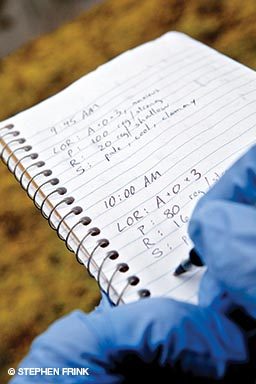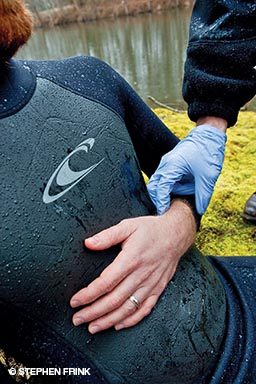Assessing vital signs (“vitals”) is a key component of good first aid. It consists of taking a series of simple measurements that provide data about a body’s functioning. These measurements can help reveal how sick or hurt a patient is and, when taken over time, whether they are getting better or worse. While the full meaning of these measurements might elude the lay provider, a carefully documented series of vitals can be very helpful to the health-care professionals who will eventually take over the care of an injured person.
Vital signs can be helpful even to first aid providers with limited medical training. Sets of vitals that are outside normal ranges typically indicate the need for some treatment or possible evacuation to a higher level of care. As an example: Anxiety, elevated heart rate, elevated respiratory rate and pale, cool, clammy skin may indicate shock, a potentially life-threatening medical condition. Shock is relatively easy to address, but it can go unnoticed if vitals aren’t monitored. Vital signs that move increasingly further from their normal range over time may indicate an even more urgent need for evacuation.
Time

To organize and keep track of your measurements, it is very important to document the time of day along with each set of vital signs. This allows you (or a subsequent caregiver) to make comparisons between sets of vitals and observe trends in the patient’s condition. The frequency with which vitals are taken depends on the patient’s condition. Seriously injured or ill patients should have their vital signs reassessed every few minutes, while hourly checks are reasonable for those who are stable.
Level of Responsiveness
An injured person’s mental status, or level of responsiveness, is probably the most important vital sign. Since the brain has top priority in the body’s distribution of resources, a decline in its status is especially important to recognize. To assess a patient’s level of responsiveness, begin talking to the person. If the person is able to respond to you, ask the following questions:
- What is your name?
- Where are we?
- What time is it (approximately)?
- What happened?
Answers to these four questions allow you to gauge a patient’s orientation to person, place, time and event. If the patient can answer all four appropriately, they would be considered “Alert and Oriented to Person, Place, Time and Event” or, more commonly, A+Ox4 (read “A and O by four”). In addition to quantifying the patient’s level of responsiveness, it’s also helpful to write down a qualifying term. Helpful qualifiers include “irritable,” “anxious” or “combative.” Words like these help round out your description of the patient’s mental status.
In the event that an injured person is awake and can respond to you but does not know the answers to any of these questions, that person can be considered alert but disoriented.

A common scale used to describe a person’s mental status is the AVPU scale. AVPU is an acronym that stands for alert, verbal, painful and unresponsive. The paragraph above describes patients who have an A rating on this scale, but sometimes ill or injured people are not alert. If the person does not respond when you attempt engagement in conversation, talk louder. In a loud voice, ask if they are OK.
If the person responds to this elevation in volume, they can be considered responsive to verbal stimulation or V on the AVPU scale. The person doesn’t have to respond verbally to be considered V; they may simply grimace or open their eyes, but any response to sound means they are a V. If the person does not respond to your verbal stimulus, you should assess responsiveness to pain. It is important not to cause harm, but simply elicit a response. A good way to do this is to pinch the patient’s tricep, just above the elbow. If this causes the patient to respond, by moving or groaning, for example, the patient is a P on the AVPU scale. Finally, a patient who does not respond to verbal or painful stimulation is considered unresponsive, or U, on the AVPU scale.
Pulse
A strong heartbeat is required to ensure an adequate supply of oxygenated blood to the body’s tissues. To assess the pulse in an unconscious person (V, P or U on the AVPU scale), use the carotid artery in the neck. Place two of your fingers gently on the patient’s trachea and slide them laterally. Do not reach across the trachea (use the near side), and do not try to assess on both sides of the neck at once.

You should feel the pulse in the carotid artery right next to the trachea. In a conscious patient (A on the AVPU scale), it is best to find the radial pulse on the wrist; this is less invasive. Checking the radial pulse is less invasive when the patient is conscious. To find the radial pulse, place two of your fingers where the base of the patient’s thumb meets the wrist. The pulse will most likely be between that spot and the most prominent tendons of the wrist.
If you are having difficulty finding the heart rate, you may be pressing too hard or not pressing hard enough. Once you locate the pulse, count the number of beats in 15 seconds. Multiply this number by four, and you’ll have the patient’s heart rate in beats per minute.
In addition to the rate, it’s important to document the rhythm and quality of the pulse. The rhythm will be either regular or irregular, and the quality will usually be described as strong or weak. Most healthy adults have a resting heart rate of between 60 and 100 beats per minute, regular and strong. People experience a natural elevation in their heart rate when performing exercise or in stressful situations. The heart beats faster to ensure sufficient oxygenation of tissues, allowing the body to respond quickly in emergencies. A person’s pulse may be elevated shortly after an emergency, but this should stabilize in people who are not seriously injured.
Respiration
Since the body can survive for only a few minutes without oxygen, it’s important to check the function of the respiratory system. If a person knows you are trying to count respirations, they will probably change the rate of breathing and skew your measurement. To get around this, transition smoothly to counting respirations as soon as you are finished checking the pulse. Once you have counted the heart rate, shift your focus to the breathing. Leave your fingers on the wrist, but watch for the chest to rise. If you’re unable to detect respirations by watching the chest, it might be helpful to watch the abdomen or the shoulders instead. Folds of the patient’s clothing might also aid your observation of respirations.
Since respirations are less frequent than heartbeats, count respirations for 30 seconds, then double the number to achieve an accurate result. As with pulse, measuring the rhythm and quality of respirations is important. Rhythm will be either regular or irregular. Words like “unlabored,” “gasping,” “wheezing” or “labored” are used to describe the quality of respirations. An adult at rest typically breathes between 12 and 18 times per minute, regular and unlabored.
Skin
Skin is the body’s largest organ, and it can be an excellent window into the body’s functioning. If the skin is pale, cool and clammy, this is a sign that the body’s resources (i.e., blood) are being diverted to more vital organs. When assessing the skin, you should take note of three different characteristics: color, temperature and moisture.
Skin color, of course, varies widely among individuals, but there are non-pigmented areas of the body where all humans are pink. The most accessible of these places is the inside of the bottom lip. Take a look and note whether the color is indeed pink or some other color. It might be pale if the person is cold, blue if they are hypoxic, red if hot or even yellow if they are suffering from some illness. Temperature and moisture of the skin are best assessed on the abdomen. These are generally more consistent there than on the hands or the face. The abdomen should be warm and dry, so if it’s cool, cold, hot or moist, that is especially important to document.
Level of responsiveness, pulse, respirations and skin condition are by no means the only vital signs, but they are important and relatively easy to assess. The only equipment necessary to measure these is a watch, a pen and paper. Other vital signs include blood pressure, lung sounds, pupils and body temperature. Though training, experience or equipment may limit your ability to care for an injured buddy in a remote environment, assessing basic vitals is something just about anybody can do to help.
DAN First Aid Training
In addition to instruction on gathering vital signs, these DAN® offers a variety of courses to teach students how to provide necessary treatment in a variety of scenarios. Courses are geared toward both professional and recreational divers and cover a wide range of first aid topics. Developed by dive medicine physicians and diving educators, DAN’s courses are easy to understand and designed to provide you with the skills and confidence you need to respond in emergencies. DAN first aid courses prepare people to manage injuries related to scuba diving as well as those that occur in other settings. All courses meet current ILCOR and AHA guidelines. Isn’t it worth a few hours one evening or weekend to learn skills that could save a life?
Learn more about DAN’s first aid courses.
© Alert Diver — Q2 Spring 2010